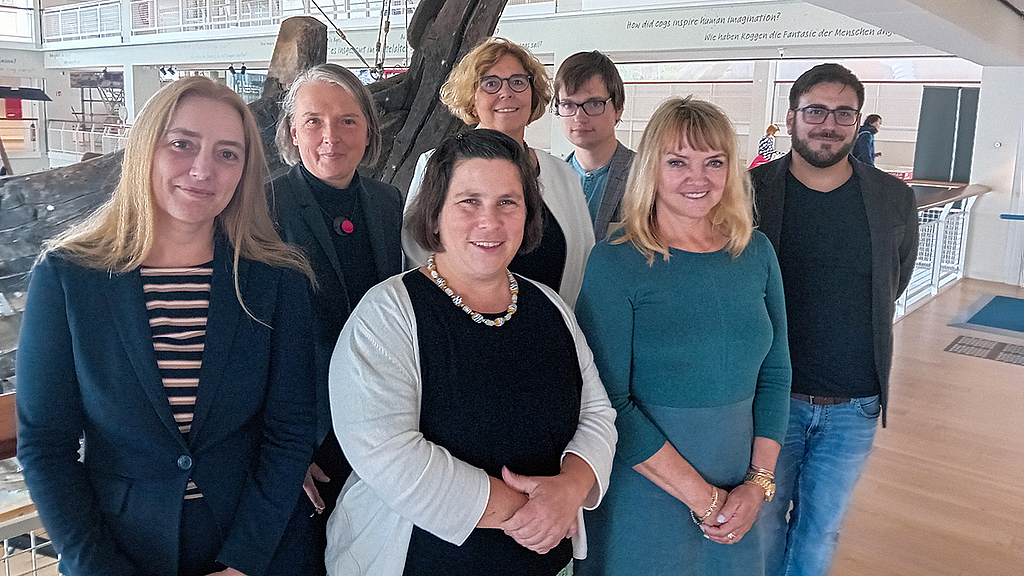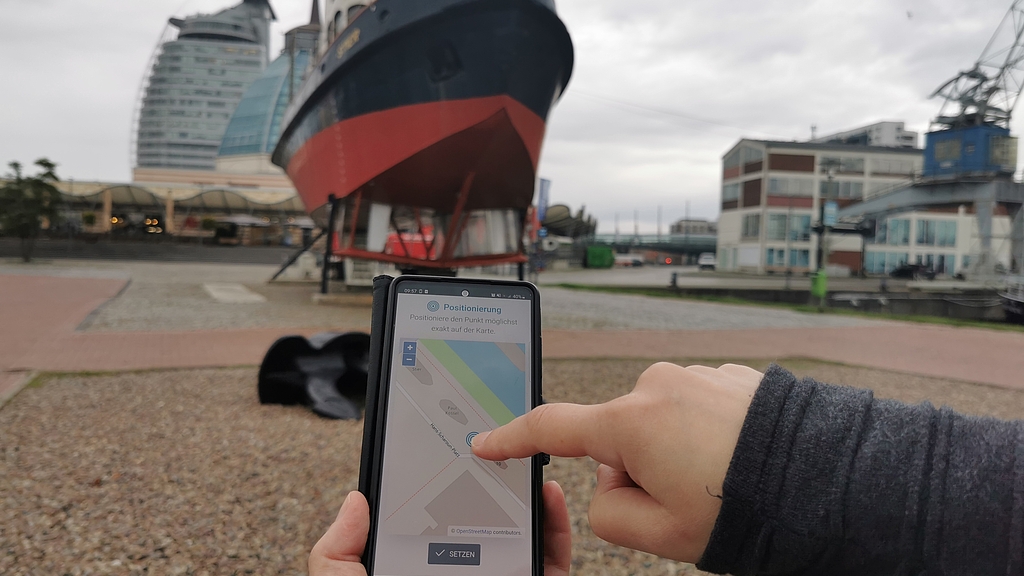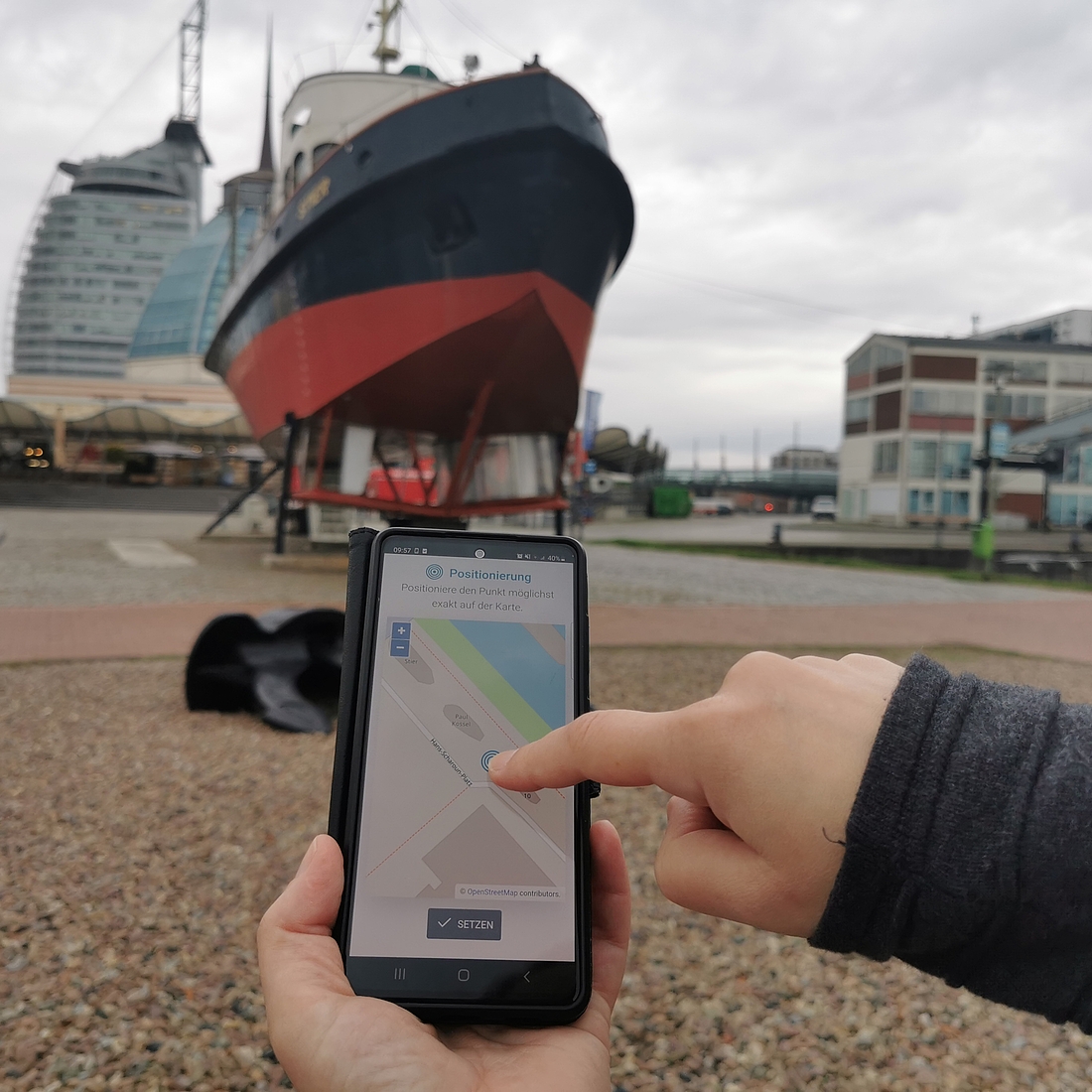More inclusion in the museum via app
With a new app, the German Maritime Museum / Leibniz Institute of Maritime History wants to make it easier for people with intellectual disabilities to visit the museum. The application is being developed in collaboration with Lebenshilfe für Menschen mit geistiger Behinderung Ortsvereinigung Bremerhaven and Ostfalia University in Wolfenbüttel as part of the Leibniz Science Campus Postdigital Participation.
Large green spheres point the way. They guide museum guests past interesting objects in the Kogge Hall to the historic ships in the Old Port. Short texts for reading or listening provide information on the whaler RAU IX, the concrete ship PAUL KOSSEL or the Bremen cog from 1380. The app on the cell phone of computer science professor Dr. Ina Schiering from the Ostfalia University in Wolfenbüttel is still a prototype, but it could soon make it easier for people to find their way through the DSM. This is also thanks to the museum group at Lebenshilfe Bremerhaven - four women and four men who find a lot of things exciting in the museum, but have difficulties with spatial orientation and longer exhibition texts. The participatory research project was developed as part of a research campus led by the Leibniz Institute for Educational Media, which focuses on social participation and digitization.
During on-site visits to the cog hall and a scavenger hunt through the museum harbor, the group members worked out in a participatory way with the researchers what is difficult for them when visiting the museum and what can help them. This is also how the green spheres were created - an earlier version featured other symbols. In a workshop, the members of Lebenshilfe chose symbols that were meaningful and understandable to them from several alternatives. "The simpler and clearer the contents of the app are, the better," is how Dr. Sandra Verena Müller, professor at the Faculty of Social Work at Ostfalia University of Applied Sciences, sums it up. "Cultural participation, along with participation in community life and occupational participation, is an important aspect of participation that is more than an add-on and should not be left behind."
The project ran over a four-year period. "The interest in the group was huge," says Rosemarie Brikmanis-Brückner from the accompanying service of Lebenshilfe Bremerhaven. It was so great that even Corona could not interrupt the collaboration. Instead of on site, the talks were held via web conferences. It gave the participants great pleasure to work creatively and to present this project in a self-determined way even beyond the region. "The museum group is very interested in helping to shape the coming phases of the project," says Brikmanis-Brückner.
"We see a lot of potential in this project," adds Selim Ercins, workshop manager and educational director at Lebenshilfe Bremerhaven. In the future, for example, the app could make it easier for people with intellectual impairments to find their way around outside the museum.
The application is designed so that cultural institutions or facilities for people with disabilities can very easily post content themselves. Programming skills are not required for this. The app itself is based on a combination of augmented reality and GPS; it therefore supplements the current perspective of the smartphone camera on site with additional information.
For DSM Director Prof. Dr. Ruth Schilling, the reasons for more inclusion in the museum are obvious: "As the German Maritime Museum, we want to be a museum for everyone, and we have to be," she says. "Our exhibitions give impetus to questions that concern us all: For example: How do we want to deal with the ocean? Or: How globally do we want to live? It is therefore all the more important that our exhibitions are low-threshold and as widely accessible as possible," she says, pointing to a whole range of inclusion activities at the DSM: starting with tactile models of the Bremen cog, through floor guide tracks, to tactile QR codes.
Since this summer, the museum has been offering audio tours under the motto "Lauschflut" (eavesdropping), which are specifically aimed at people with visual impairments and limited mobility. Other digital services will soon be added. In the future, for example, the ships in the museum harbor can be explored digitally with the help of 360-degree images. In this way, people who are unable to come on board due to mobility impairments will also be able to get an impression of what it looks like on and below deck of the historic ships.
Participation also plays a major role in the development of the respective offerings: "Our approach is not to design offerings for people with impairments, but to do it together with them," says digital curator Dr. Isabella Hodgson. "After all, those who have an impairment know best themselves what helps him or her in everyday life. And that knowledge, in turn, helps us break down barriers in both the analog and digital realms."

Inclusion and participation in the museum as a common concern: (from left to right) Dr. Isabella Hodgson (DSM), Prof. Dr. Ina Schiering und (Ostfalia-Hochschule) Prof. Dr. Ruth Schilling (DSM), Prof. Dr. Sandra Verena Müller (Ostfalia-Hochschule), Aleksander Solinski (DSM), Rosemarie Brikmanis-Brückner und Selim Ercins (Lebenshilfe Bremerhaven).
Photo: DSM / Thomas Joppig

Credit: DSM / Annica Müllenberg

